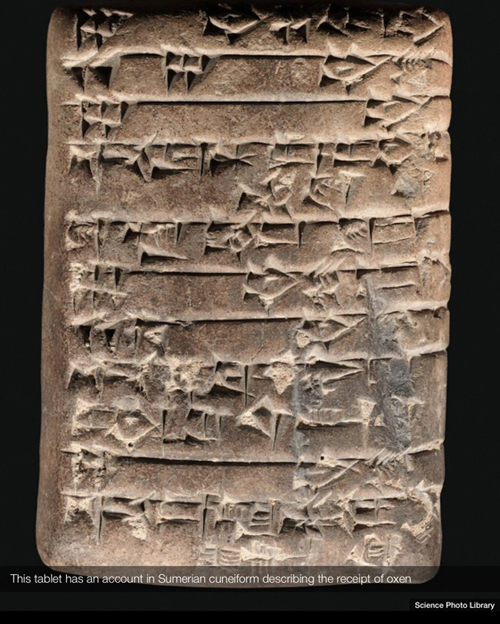Counting on you
Some fascinating podcasts are to be found in a ’50 things that made the modern economy’ series on the BBC World Service by Tim Harford, a BBC Business Correspondent. The two most interesting for me so far have been on ‘Tallies’ and on ‘Cuneiform writing’, with both concerned with counting, and also writing and thence letters.
Many tallies are to be found in the miscellaneous parts of the larger white South Africa family collections which WWW research has been concerned with. These are, however, on paper and in the form of fairly simple counts, rather than in their earliest forms, which were agreements or payments or payments due notched into wood which was then split down the middle with each party to a transaction taking one half of the record. But the very earliest take a more simple form. The earliest known example dates from a staggering 20,000 years ago and is in the more simple form of notches made on a piece of bone – the Ishango bone is shown here.

This has recorded on it counts of something. It is surprisingly similar to the many examples of recorded tallies found in the detritus and miscellaneous parts of the archive collections of white farming households in South Africa, with the notches in the latter case being lines drawn on a piece of paper in groups of four crossed with a fifth. Sheep, oxen, horses, muids of mielies (corn) all figure large.
The podcast on cuneiform writing was even more fascinating, for two main reasons. Firstly, while cuneiform started out 5000 years or so ago in a simple way, of say a wine vat incised on a clay tablet representing an incoming or outgoing wine vat, it developed in a uber-representational manner. This was because small clay tokens became used to represent the wine vats or other objects, and the cuneiform incisions started representing the clay tokens that represented the objects. A very beautiful cuneiform tablet of this latter period is shown here.

Secondly, from this ‘writing proper’ developed, including that communicative form of one person writing to another separated from them in time and space that we call the letter. But it started with the ordinary everyday business of making things happen.
For as long as these things were known about, they were a mystery, and for a long while nobody understood cuneiform. It took a woman to crack the mystery, the French archaeologist Denise Schmandt-Besserat, who in the 1970s when working on some even older examples put two and two together and came up with the representational premise involved. This is now known as correspondence counting – the tokens that were shaped like loaves could be used to count loaves, the ones shaped like wine vats could be used to count wine vats. What Schmandt-Besserat had realised is that the tablets had been used to record the back-and-forth of the tokens, which themselves were recording the back-and-forth of the sheep, grain and wine. Just like writing – indeed, it is exactly writing, that commodious, flexible and endlessly delightful representational system.
These are 10 minute podcasts of sheer delight and can be accessed through the BBC World Service website and via BBC IPlayer Radio. The one on paper is also highly recommended, while others of them are on very diverse kinds of topics such as the elevator, air conditioning, contraception and passports.
Click the picture below to flip through Liz’s 16 June News Mag by Liz Stanley

Last updated: 15 June 2017





